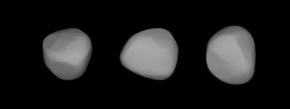 A three-dimensional model of 218 Bianca based on its light curve. | |
| Discovery | |
|---|---|
| Discovered by | Johann Palisa |
| Discovery date | 4 September 1880 |
| Designations | |
| (218) Bianca | |
| Pronunciation | /biˈæŋkə/[1] |
Named after | Bianca Bianchi |
| A880 RA | |
| Main belt | |
| Orbital characteristics[2] | |
| Epoch 31 July 2016 (JD 2457600.5) | |
| Uncertainty parameter 0 | |
| Observation arc | 122.41 yr (44709 d) |
| Aphelion | 2.97915 AU (445.674 Gm) |
| Perihelion | 2.35524 AU (352.339 Gm) |
| 2.66719 AU (399.006 Gm) | |
| Eccentricity | 0.11696 |
| 4.36 yr (1591.0 d) | |
Average orbital speed | 18.24 km/s |
| 170.102° | |
| 0° 13m 34.565s / day | |
| Inclination | 15.2006° |
| 170.635° | |
| 63.0175° | |
| Physical characteristics | |
| Dimensions | 60.62±1.4 km[2] 56.735 km[3] |
| 6.337 h (0.2640 d)[2] 6.33717 h[4] | |
| 0.1746±0.008[2] 0.1979 ± 0.0407[3] | |
| S[3] (Tholen) | |
| 8.60,[2] 8.607[3] | |
Bianca (minor planet designation: 218 Bianca) is a sizeable Main belt asteroid. It is an S-type asteroid. It was discovered by Johann Palisa on 4 September 1880, in Pola and was named after the Austro-Hungarian opera singer Bianca Bianchi (real name Bertha Schwarz). The Vienna newspapers contained several published accounts of the circumstances surrounding the honor extended to the diva in Spring 1882.[5] In the late 1990s, a network of astronomers worldwide gathered lightcurve data that was ultimately used to derive the spin states and shape models of ten new asteroids, including (218) Bianca. The shape model for this asteroid is asymmetrical.[4][6]
References
- ^ Benjamin Smith (1903) The Century Dictionary and Cyclopedia
- ^ a b c d e "218 Bianca". JPL Small-Body Database. NASA/Jet Propulsion Laboratory. Retrieved 12 May 2016.
- ^ a b c d Pravec, P.; et al. (May 2012), "Absolute Magnitudes of Asteroids and a Revision of Asteroid Albedo Estimates from WISE Thermal Observations", Asteroids, Comets, Meteors 2012, Proceedings of the conference held May 16–20, 2012 in Niigata, Japan, no. 1667, Bibcode:2012LPICo1667.6089P. See Table 4.
- ^ a b Durech, J.; et al. (April 2007), "Physical models of ten asteroids from an observers' collaboration network" (PDF), Astronomy and Astrophysics, 465 (1): 331–337, Bibcode:2007A&A...465..331D, doi:10.1051/0004-6361:20066347.
- ^ Schmadel, Lutz D. (2003). Dictionary of minor planet names (5th ed.). Springer. pp. 34–35. ISBN 978-3-540-00238-3.
- ^ Durech, J.; Kaasalainen, M.; Marciniak, A.; Allen, W. H. et al. "Asteroid brightness and geometry", Astronomy and Astrophysics, Volume 465, Issue 1, April I 2007, pp. 331-337.
External links
- Asteroid Lightcurve Data File
- 218 Bianca at AstDyS-2, Asteroids—Dynamic Site
- 218 Bianca at the JPL Small-Body Database
